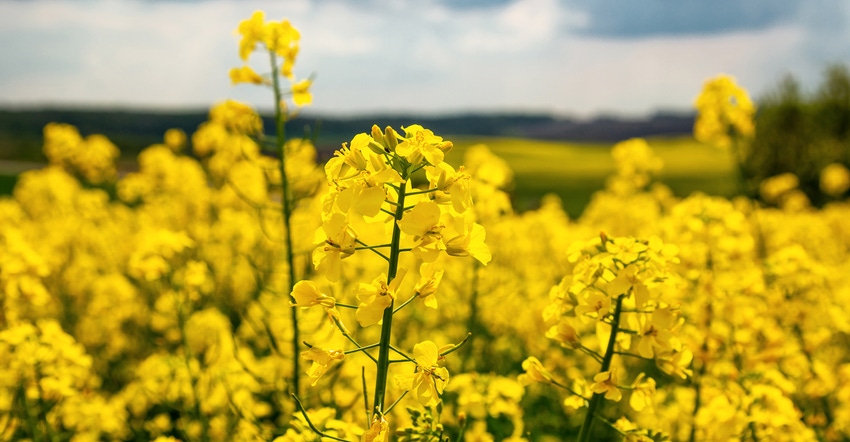August 3, 2022

Traditionally, canola has been swathed. But in recent years with the increased availability of pod shatter-resistant hybrids, straight-cutting has become the new harvest trend.
Both swathing and straight combining have their places based on conditions at harvest. A timely straight cut can save time and money by eliminating the cost of swathing. Heavier canola stands are better suited for straight combining than thinner stands because of the decreased likelihood of shattering from wind.
In the absence of pod shatter tolerance, straight combining has resulted in yield losses of 8% to 54%, as reported by the Canola Production Center in Canada.
Many farmers tend to use desiccants to attain uniform maturity for straight-cutting canola. Several preharvest herbicides are labeled for use as a desiccant in canola. Check labels to verify that products can be used in your situation. Desiccants should be applied when more than 60% to 75% of the seeds have started to turn color (see the herbicide labeled instructions).
Research has shown that when the desiccant application is timed properly, crop quality parameters —including yield, oil content, seed loss, green count and grade — generally were similar for desiccated canola compared with swathing.
Fields posing severe challenges to straight-combining canola are those prone to:
early frost
excessive lodging
uneven maturity
infestation with green weeds and diseases (clubroot, blackleg and white mold)
For these situations, swathing may be the better choice.
Harvest at optimal time
Swathing canola at the optimum stage of ripening reduces green seed problems and seed shatter losses, and ensures the quality required for top grades and prices. Swathing can begin in canola at more than 60% color change.
When canola plants consist only of stems, stem branches and pods, the crop probably is very near the optimum time for swathing. Seeds in all pods on a plant complete filling (physiological maturity) at about 40% moisture and then slowly turn from green to light yellow or reddish brown, brown or black, depending on the hybrid.
In dry, hot weather of 90 degrees F and above, canola seed can go from 10% to 50% seed color change in just three to five days. Once filled, seeds rapidly lose moisture at about 2 to 3 percentage points or more each day, depending on the weather.
Inspect fields every two to three days when some color change occurs in the first-formed pods on the bottom of the main stem. To determine when a field of canola is ready to swath, examine plants from different parts of the field. When examining the plants, consider varying soil types, low-lying areas, available soil moisture and exposed early ripening areas.
Seeds with only small patches of color should be counted as a color change. The color of the seed is more important than the overall color of the field in determining the stage of maturity. When seeds in the bottom pods slightly turn color, seeds in the top last-formed pods are filled or nearly filled.
Avoid swathing when temperatures are above 86 degrees F, and in dry and windy weather, as the pods and seeds dry out much faster in the swath before chlorophyll clears up in the seed. Swathing during the cool evening hours, at night or in the early morning will allow the seed to dry down at a slower rate, lowering the chances of green seed in the harvested canola.
Swathed canola is ready to harvest in five to 14 days after cutting the crop. If there is still green seed in the pods, allow a few extra days in the swath for more color change. Green seed color is fixed once the crop is combined and put into storage.
Source: North Dakota State University is solely responsible for the information provided and is wholly owned by the source. Informa Business Media and all its subsidiaries are not responsible for any of the content contained in this information asset.
You May Also Like




